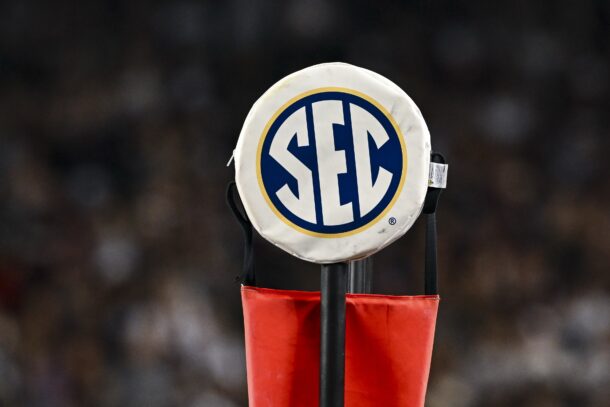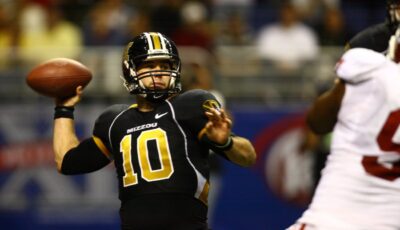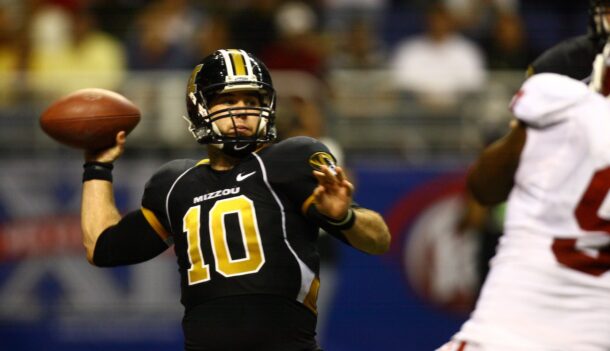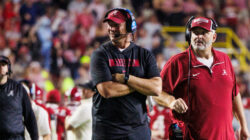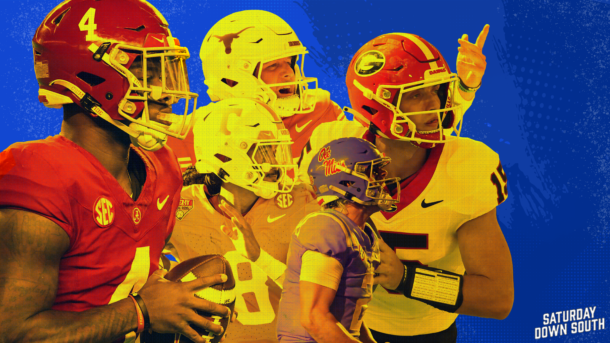
2024 SEC QB Power Rankings, Week 1: Quinn Ewers arrives right on schedule
By Matt Hinton
Published:
Quarterbacks: There are a lot of them! Each week throughout the season, we’ll help you keep the game’s most important position in perspective by ranking the SEC starters 1-16 according to highly scientific processes and/or pure gut-level instinct. Previously: 2023 Final Rankings.
1. Quinn Ewers, Texas
A blue-chip Texas quarterback who actually lives up to the hype? College football really has changed. After a lost decade in Austin, Ewers arrived with messianic expectations and is on right on schedule to meet them.
That certainly wasn’t the case a year ago, coming off a sobering, injury-riddled debut in 2022 that left Ewers’ status in doubt on the same depth chart as the equally exalted Arch Manning. Up to the challenge, he came back in ’23 looking leaner and more mature, shorn of his trademark mullet, and significantly more in sync with Steve Sarkisian’s offense.
Ewers wasted no time reminding the rest of the country why he was touted as highly as he was in a 349-yard, 3-touchdown ambush of Alabama in Week 2, the catalyst for a vastly improved sophomore campaign across the board. He finished with best single-season passer rating (158.6) and QBR (78.7) for a Texas quarterback since Colt McCoy’s Heisman runner-up campaign in 2008; the Longhorns finished in their first Playoff game. Manning’s name barely came up.
On the scouting side, the jury is still out.
Ewers is not generally considered a no-brainer prospect on the order of Trevor Lawrence or Caleb Williams at the same stage of their careers, or even the top quarterback in a consensus-defying 2025 class. There are lingering questions about his consistency and accuracy, which still has a tendency to come and go. But there is no doubt about his raw tools, or, given the leap from Year 1 to Year 2, his capacity for growth. Another step forward in Year 3 will put him within range of the Heisman, a deep Playoff run, and the top of the draft. If the final product is as good as advertised, it will be well worth the wait.
– – –
(Last week: n/a)
2. Carson Beck, Georgia
Were there ever any doubts about Beck as a worthy successor to Stetson Bennett IV? If there were, they dried up in a hurry. After 3 uneventful seasons as a backup, Beck slid seamlessly into the spotlight in 2023, enjoying all the benefits of being QB1 at Georgia — reliable protection, an arsenal of mostly interchangeable playmakers, a defense that afforded him plenty of margin for error — while putting up a virtually identical stat line to Bennett’s in 2022. UGA finished un the top 5 nationally in total and scoring offense, and the 6-4, 220-pound Beck emerged as the kind of NFL-ready pocket presence that the diminutive Bennett was constantly being compared against.
#Georgia QB Carson Beck (6-4, 220)
On-balance, in-rhythm thrower. Shows anticipation. Decisive and trusts his eyes. pic.twitter.com/I7wU2mSM2h
— Jordan Reid (@Jordan_Reid) May 24, 2024
Bennett, of course, boasts a pair of ace cards that Beck does not: Back-to-back national championship rings. Georgia’s 27-24 loss to Alabama in the SEC title game abruptly ended a 29-game winning streak, a 24-week run at the top of the AP poll, and the bid for a three-peat. It also guaranteed Beck would be back for his final year of eligibility under the banner of “unfinished business.” Georgia remains the safest bet to win it all in the first year of the expanded Playoff, which by default makes Beck the safest bet to win the Heisman. Anything less than a December trip to New York for the award ceremony ahead of a January trip to Atlanta for the CFP title game will go down as another sorely missed opportunity.
– – –
(Last week: n/a)
3. Jalen Milroe, Alabama
In retrospect, the panic over Milroe’s shaky start last September looks faintly ridiculous. At the time, though, it was very real — real enough that Nick Saban briefly decided to his explore his options while Milroe chilled on the bench, and that even after he was restored to QB1 it took roughly half the season for Bama fans to stop holding their breath every time the ball left his hand.
But then, week by week, the wins kept adding up: 11 in a row, all the way through a galvanizing win over LSU, a miracle finish at Auburn, and an SEC Championship upset over Georgia that recast a season on the brink as a triumph over adversity. In the process, Milroe’s arc from scapegoat to MVP of the season’s biggest win confirmed him as a rising star.
A mediocre turn in the Tide’s semifinal loss to Michigan took some of the wind out of his sails entering the offseason. Still, Milroe’s ceiling remains as high as any returning starter in the country, beginning with his singular combination of home-run speed and home-run arm strength at 6-2, 220 pounds.
As a playmaker, he has nothing left to prove. Assuming his early struggles with pocket presence and ball security are behind him, the next step to becoming a complete package is making the routine throws look more … well, routine.
– – –
(Last week: n/a)
4. Jaxson Dart, Ole Miss
After a deflating finish in 2022, Lane Kiffin put Dart on notice by bringing in a pair of high-profile transfers to compete for his job in ’23. Dart rose to the occasion: He fended off the competition in the offseason, started every game, improved his production across the board and cut his interceptions in half. Ole Miss set a school record for wins (11) and logged its best finish in the AP poll (9th) since 1969.
Dart’s return and a loaded transfer class have the Rebels thinking Playoff in 2024, but taking the next step will not be as simple as putting one foot in front of the other. Their only losses last year were both double-digit defeats against the two best teams on the schedule, Alabama and Georgia — the latter coming in a sobering November blowout — making the gap between Ole Miss and the SEC’s real national contenders all too clear. Not coincidentally, they were also two of Dart’s least efficient games as a passer and lowest-graded outings per PFF. The Rebels avoid Bama this time around, but still face Georgia and LSU while adding Oklahoma, all in a 5-week span in October and November. As it stands, Dart can already take his status as one of the top QBs in school history to the bank. Whether he goes out on top depends largely on those three Saturdays.
– – –
(Last week: n/a)
5. Brady Cook, Missouri
They might be reluctant to admit it now, but Mizzou fans had their doubts about Cook, for perfectly justifiable reasons. I certainly did. (I’m on the record: In last year’s power rankings Cook opened the season ranked 13th out of 14.) At this time last year, he was still in the midst of his second consecutive offseason as the local lightning rod. Eli Drinkwitz publicly tried and failed to land a transfer to bump Cook from the top of the depth chart in 2022, before he had started his first regular-season game. After a mediocre debut that fall, speculation resumed that Cook’s days as QB1 were numbered, whether his replacement came via the portal or from one of the more traditionally touted underclassman already on campus.
Instead, Cook held onto the job and quickly emerged as one of the most improved quarterbacks in the country, starting hot and remaining steady throughout. He accounted for multiple touchdowns in 11 games; a 140+ passer rating in 10 games; and a 70+ QBR score in nine games. Compared to 2022, his overall yards per attempt rose by nealy 2 full yards, from 7.2 to 9.0. He led game-winning drives to beat Kansas State early and Florida late; posted his only subpar stat line in a competitive road loss at Georgia; and capped an 11-2 season by leading a Cotton Bowl win over Ohio State. After 8 consecutive years of thorough mediocrity, Missouri finished No. 8 in the AP poll, and No. 3 in the SEC behind Alabama and Georgia.
None of which implies Cook is suddenly more likely to be mistaken for a next-level specimen in Year 5, even with Luther Burden III — who most certainly is — on the receiving end. But he is well on his way to going out as a Mizzou legend, which is quite the journey.
– – –
(Last week: n/a)
6. Conner Weigman, Texas A&M
Coming off a promising finish in 2022, Weigman opened his sophomore campaign as one of the league’s most intriguing wild cards. Coming off a season-ending injury that cost him most of 2023, he still is. Technically, he remains in the green zone in Year 3 with just 253 attempts across 9 career games. Still, Weigman shown enough in that limited span to keep his blue-chip rep intact.
Prior to his injury last year he was off to a fine start, putting up big numbers in terms of Total QBR (87.5) and overall PFF grade (91.9). Considering A&M’s opening-day starter has failed to make it out of September in any of the past 3 seasons, the prospect of a healthy, productive campaign behind center almost feels like a revelation.
– – –
(Last week: n/a)
7. Garrett Nussmeier, LSU
The blue-chip vet willing to wait his turn at the same school he signed with out of high school is an endangered species, but they’re not dead yet. Last year, long-serving backups Carson Beck and Jalen Milroe were the top quarterbacks in the conference as first-year starters. This year, the mantle falls to Nussmeier, one of the few remnants in Baton Rouge of the Ed Orgeron administration. A 4th-year junior, he’s ceded the stage the past 2 years to Heisman winner Jayden Daniels, who left last winter as the sport’s least enviable act to follow.
No one in their right mind expects Nussmeier to match the absurd statistical bar Daniels set in 2023, especially with chief play-caller Mike Denbrock and a pair of first-round wideouts also leaving town. The question is just how close LSU needs him to come opposite a defense that frequently offset the offense’s best efforts. The Tigers gave up 30+ points in 8 of their 10 games against Power 5 opponents, and 40+ points in all 3 losses. Other than exiled coordinator Matt House, the personnel on defense is essentially the same. If the offense is destined to regress to the mean, they desperately need the need the defense to do the same.
– – –
(Last week: n/a)
8. Nico Iamaleava, Tennessee
The top of this list is too crowded with proven commodities to overrate a guy with 1 career start. But if I had to bet on any player here ending the season ranked significantly higher than he’s starting out, Iamaleava would be a fairly easy choice.
The highest-rated QB recruit at Tennessee since you-know-who, his gap year behind the underachieving Joe Milton III in 2023 only fed the hype as it became clear the present was no match for the anticipation. The soft launch of the Iamaleava era in the Citrus Bowl was a hit, resulting in a 35-0 rout over Iowa and a packed bandwagon entering the offseason.
If you’re looking for excuses to short his stock, start with the fact that the highlight reel of Iamaleava’s 4-touchdown effort against the Hawkeyes was more impressive than his stat line; altogether, he accounted for just 178 total yards, took 6 sacks, and benefited from a pair of rapid-fire takeaways in the second half that led directly to 2 of the Vols’ 5 touchdowns.
Per PFF, he didn’t complete a pass under pressure, only getting off 2 on a dozen pressured drop-backs. Obviously, he remains a project — a multimillion-dollar, golden-armed project with an elite combination of size and speed, but still. It’s a tough league; we’re trying to show some restraint here. Even if it winds up looking quaint.
– – –
(Last week: n/a)
9. Jackson Arnold, Oklahoma
Arnold, like Iamaleava, was a 5-star prospect in the 2023 class. Also like Iamaleava, he spent his first year on campus chilling behind an upperclassman before earning his first career start in a third-tier bowl game. That’s where their tracks begin to diverge.
Unlike Iamaleava, Arnold is stepping into a role that takes elite production for granted: Since the turn of the century, starting quarterback at Oklahoma is the most consistently decorated position in the sport. No one is walking in the door as a would-be messiah. And (more important for our purposes) Arnold’s debut was a mixed bag: While he threw for 361 yards and 2 touchdowns, he was also picked 3 times in a 38-24 loss Arizona in the Alamo Bowl.
Fine, for a true freshman just getting his feet wet in a game sponsored by a gas station. For an entrenched starter assigned with Oklahoma in the Playoff hunt against one of the SEC’s steepest schedules, the giveaways are a concern. The Sooners didn’t let the most experienced returning quarterback in the country, Dillon Gabriel, exit via the portal just to bring along his understudy slowly. In Year 2, it’s Arnold’s show, ready or not.
– – –
(Last week: n/a)
10. Brock Vandagriff, Kentucky
A 5-star prospect who could have hit Georgia’s campus with a Hail Mary from his high school stadium, Vandagriff was born to be a Dawg. Destiny, however, didn’t reckon on three years in the freezer behind Stetson Bennett IV and Carson Beck. With Beck’s decision to return to school, Vandagriff couldn’t afford a fourth. The opportunity to finally be an SEC starter beckoned at Kentucky, and he took it.
If his stock is not as high as it was 4 years ago, it’s easy to chalk that up to simply bad timing. The past 2 starters in Lexington, Will Levis and Devin Leary, also transferred in as upperclassmen, and both left as draft picks despite mediocre production.
The bar for Vandagriff is set a little bit higher: After all, if Beck had opted to go pro, his former understudy would almost certainly be near the top of the preseason Heisman odds right now as the face of the No. 1 team in the country.
His surrounding cast at Kentucky can’t match Georgia’s depth, but the Wildcats’ front-line receivers (Barion Brown, Dane Key and North Texas transfer Ja’Mori Maclin) certainly rival any of the potential combinations Vandagriff would be throwing to in Athens. If the o-line holds up it’s end of the bargain, there’s no reason he should be graded on a curve.
– – –
(Last week: n/a)
11. Graham Mertz, Florida
A beneficiary of the free COVID year, Mertz has played a ton of football at the Power 5 level, and has the veteran’s knack for avoiding the bad play. In his first year as a Gator, he posted both the highest completion percentage and lowest interception percentage of any full-time SEC starter, finishing with 20 touchdowns to just 3 picks before his season was cut short by a fractured collarbone in the next-to-last game.
The flipside, though, was an utter lack of downfield juice.
Per PFF, Mertz averaged just 6.7 air yards per attempt, lowest in the Power 5, with slightly more than 30% of his attempts landing behind the line of scrimmage. Factor in the exit of the resident deep threat, first-rounder Ricky Pearsall, and those numbers look even more alarming.
There’s a lot to be said for the benefits of being risk-averse, especially opposite a reliable defense. Unfortunately for Mertz, he was opposite a defense that was routinely lit up in conference play, allowing at least 33 points in all 5 of Florida’s SEC losses. (The scoreboard was only the tip of the iceberg — the further you drill down into Florida’s defensive stats in 2023, the worse they look.)
The Gators are also facing an absolutely brutal schedule, one that opens with No. 19 Miami, closes with Florida State, and features 6 teams in the conference slate also ranked in the preseason AP poll. The idea of Mertz dinking and dunking his way through that gauntlet in a make-or-break year for coach Billy Napier does not inspire confidence, to put it mildly. Expect 5-star freshman DJ Lagway‘s presence to loom large, whether he actually winds up taking any meaningful snaps or not.
– – –
(Last week: n/a)
12. Taylen Green, Arkansas
The KJ Jefferson era Fayetteville is over after 3 years, 39 starts, and an underwhelming send-off in 2023. Enter Green, a 4th-year junior via Boise State whose profile looks awfully familiar. Like Jefferson, Green is certifiably huge, listed at 6-6, 230 pounds, and alarmingly mobile for his size, running for 1,070 yards (excluding sacks) and 19 touchdowns over the past 2 years.
Also like Jefferson, the initial excitement over his potential at Boise gradually yielded to frustration as he struggled to put it all together as a passer. Although he remained the nominal starter, Green was essentially demoted last year to co-pilot alongside the significantly less imposing Maddux Madsen, who served as the designated passer until he suffered a season-ending knee injury in November.
Ironically, Green’s last game as a Bronco, 44-20 win over UNLV in last December’s Mountain West Championship Game, was arguably his best: He set career highs for efficiency (237.2) and QBR (97.8), as well as season-highs for total yards (316) and touchdowns (4) on just 23 plays.
Taylen Green with an unbelievable run to give Boise State a 28-14 lead
— WestCoastCFB (@WestCoastCFB) December 2, 2023
The upside is plain enough. When he looks good, he looks unstoppable. If the Razorbacks’ new offensive coordinator — I still can’t believe I’m typing this — Bobby Petrino can unlock his full skill set, Green has a chance to be a game-changing presence. But Arkansas fans don’t need to be reminded how wide the gulf between if and reality can be.
– – –
(Last week: n/a)
13. Payton Thorne, Auburn
How hard did Auburn try to replace Thorne via the portal this offseason? Not hard to enough to actually do it. The Tigers did briefly appear to be in the running in January to land reigning Conference-USA MVP Kaidon Salter, who played for Hugh Freeze at Liberty in 2021-22, before Salter opted to withdraw his name from the portal. But that was already relatively late in the winter portal window to come by a potential starter; by the time the spring window opened up April, the pickings were even slimmer.
So, Thorne it is.
It could be worse. Although Thorne ranked near the bottom of the SEC statistically, he was steady enough to preside over a 6-win regular season with legitimately competitive losses against Georgia, Ole Miss, and, of course, Alabama. He was more effective in the zone-read game than anyone anticipated, especially in the nail-biters against UGA and Bama. And Auburn did work to improve a dire outlook at wide receiver, importing an entirely new two-deep headlined by 5-star freshman Cam Coleman, who stole the show in the spring.
At the end of the day, though, barring an unlikely leap as a passer in Thorne’s 6th and final college season that’s all lipstick on a pig. If the situation reaches the “looking to the future” stage, freshmen Hank Brown and Walker “Don’t Call Me Walter” White are waiting for their audition.
– – –
(Last week: n/a)
14. Blake Shapen, Mississippi State
Shapen comes to Starkville from Baylor, where he started 23 games over 3 years to little fanfare. He regressed from 2022 to ’23, when he missed 4 games due to knee and hand injuries and ranked last among Big 12 starters in Total QBR. The Bears finished 3-9 while averaging a league-low 23.1 points; Shapen’s name appeared in the portal immediately following the finale as part of a general house-cleaning.
He’s resetting in Year 5 along with the rest of the Mississippi State offense, which barely resembles the unit that finished last in the SEC in scoring offense last year in the wake of Mike Leach’s sudden death in December 2022.
The Bulldogs were unmoored, enduring key injuries — most notably to long-tenured QB Will Rogers, who missed a month — and never looking like a team with a coherent identity.
Enter Jeff Lebby, a respected play-caller from the Baylor family tree (literally: Art Briles is his father-in-law) with previous stops as offensive coordinator at UCF under Josh Heupel, Ole Miss under Lane Kiffin, and most recently Oklahoma under Brent Venables. In addition to landing Shapen, Lebby also upgraded a juiceless receiving corps with transfers Kelly Akharaiyi, a first-team All-Conference-USA pick in 2023 at UTEP, and Kevin Coleman, a former top-100 recruit who spent his first 2 college seasons at Jackson State and Louisville. The new system is not the Air Raid, exactly, but it is a system, which is a step in the right direction.
– – –
(Last week: n/a)
15. Diego Pavia, Vanderbilt
Up to this point, it’s been a pretty blue-chip list, full of specimens who have been honed and camped and touted since before they stared shaving. Then there’s Pavia, who arrives in the SEC from about as far off the beaten path as they come in this league.
A 5-foot-[inaudible] high school wrestling champ from Albuquerque, NM, Pavia was ignored by recruiters, ultimately landing in the JUCO ranks at the New Mexico Military Institute. (That’s in Roswell, spiritual home of little green men.) There, he won the starting job as a freshman and led NMMI to an improbable national championship as a sophomore. Still, Pavia couldn’t get a sniff from outside the Land of Enchantment, going unranked by most of the recruiting sites and landing in the forsaken outpost that is New Mexico State.
He just kept winning. In 2 years at NMSU, Pavia posted an eye-opening 14-9 record as a starter, overseeing just the second 10-win season in school history in 2023. (The previous one having come in 1960.)
His big break came last November in a 31-10 beatdown at Auburn that put the Aggies and their feisty, sawed-off QB on the national radar. When Vanderbilt hired his offensive coordinator, Tim Beck, to revive its flat-lining attack, Pavia hitched a ride, arriving in Nashville in the spring as the presumptive starter — and, not for nothing, with 1 more SEC win under his belt than either guy he’s replacing managed in their entire Vandy careers. The long-suffering tandem of Ken Seals and AJ Swann portaled out last December with a combined 0-25 record in conference play.
Whatever else there was to say about them, Seals and Swann could both pass for SEC starters when they walked out for the coin toss, which Pavia — already voted a team captain — does not. (Vandy lists him at 6-feet even, which is about as believable as a guy who lists himself as 6-feet on Tinder.) Any conference win the Commodores might pull off in his final year of eligibility will still go down as a significant upset, and he has viable competition from Utah transfer Nate Johnson if/when the season goes sideways. Clark Lea does not have the luxury of sitting tight through another winless slog in league play. But at the bare minimum Pavia is unlikely to inspire coach Clark Lea at any point to utter the words “he gave us a chance to punt,” and for that alone he is an upgrade.
– – –
(Last week: n/a)
16. LaNorris Sellers, South Carolina
No offense to Sellers, who I do not actually expect to finish the season … well, in the cellar. He just hasn’t played. What brief glimpses the locals have seen of him so far, they like.
For one thing, Sellers is huge, cutting a KJ Jefferson-esque figure at 6-3, 242 pounds. In limited action last year, he accounted for 3 garbage-time touchdowns on just 17 snaps while biding his time behind Spencer Rattler.
He fended off a token challenge in the spring from Auburn transfer Robby Ashford, and looked the part in the spring game, as spring games go. Fans are going to quickly rally around the trademark specs he wears under his helmet. He has a chance to move the needle. We’ll revisit his standing here after he’s attempted his first pass against a live opponent that isn’t Furman.
– – –
(Last week: n/a)
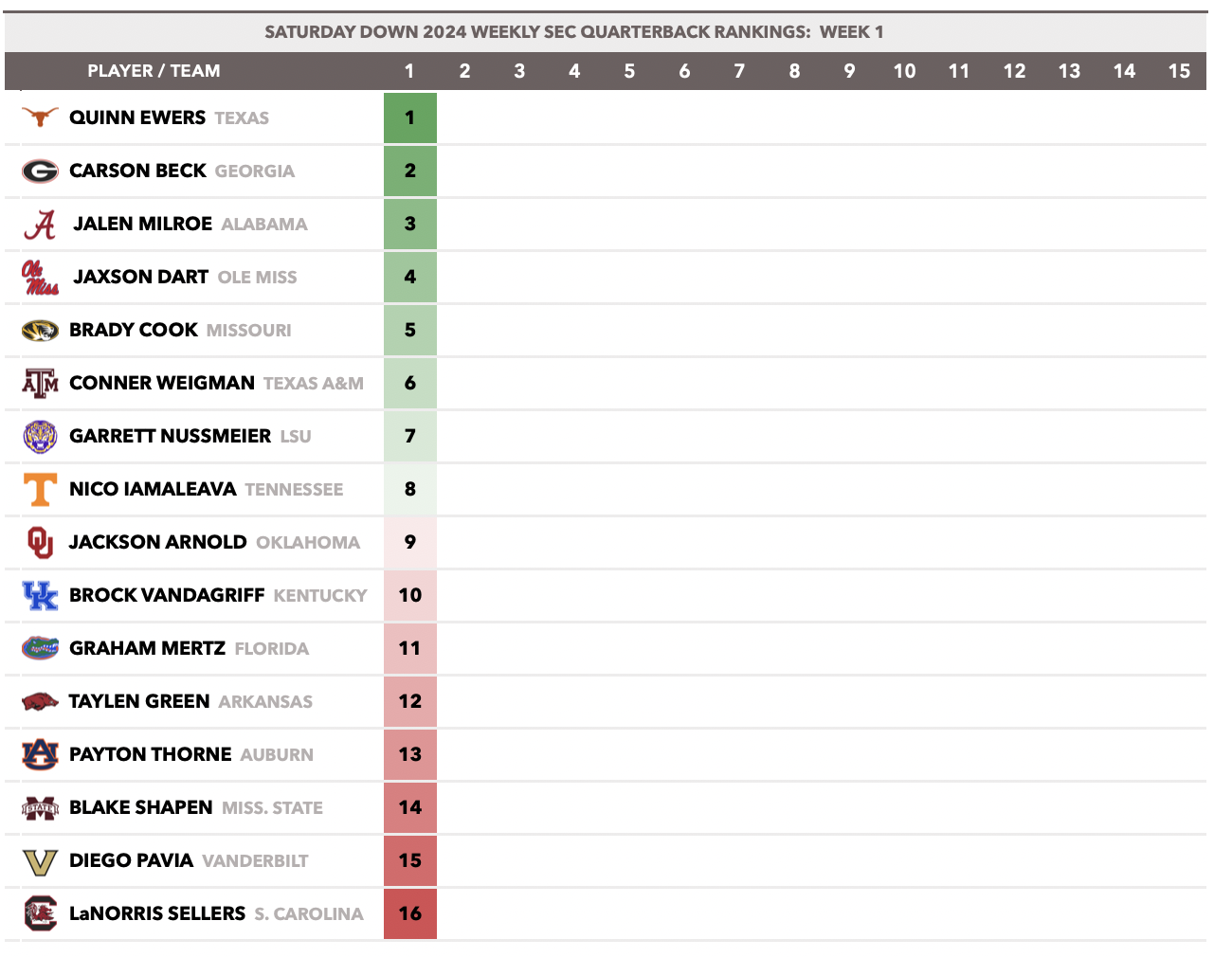
• • •
Sleeper is one of our favorite apps like PrizePicks. Remember to use promo code SOUTHXL when you sign up for an account today and you’ll receive a first-time deposit match of up to $100:
Matt Hinton, author of 'Monday Down South' and our resident QB guru, has previously written for Dr. Saturday, CBS and Grantland.
